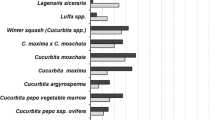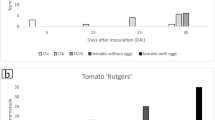Abstract
Meloidogyne enterolobii (syn. M. mayaguensis) has been reported to cause severe damage in commercial guava orchards and other plants in Central and South American countries. Considering the risk of introduction and dissemination of this pest in the European region, M. enterolobii was placed on the EPPO A2 list in 2010. The use of non-host fruit species is a recommended strategy to manage root-knot nematodes in infested guava orchards. This study screened 89 plant genotypes from 25 fruit plants of economic importance, plus two susceptible controls (guava and tomato) for its host status to M. enterolobii. Three to eight months after inoculation, nematode reproduction factor (RF) was used to characterize host suitability of fruit crops to this nematode. Ten banana genotypes, six Barbados cherries, one fig, two grape rootstocks and six melons were rated as good hosts for this nematode. Sixteen fruit plants behaved either as non-hosts or poor hosts to M. enterolobii, including assaí, atemoya, avocado, cashew nut, citrus, coconut, grape, jabuticaba, mango, mulberry, papaya, passion fruit, sapodilla, soursop, starfruit and strawberry. For the future, field experiments in areas infested by this nematode are essential to confirm the greenhouse results. These non-host fruit species can replace in the future eradicated guava trees in fields severely infested by this nematode and become an economic option for growers where M. enterolobii is considered a serious problem.
Similar content being viewed by others
References
Bitencourt, N. V., & Silva, G. S. (2010). Reproduction of Meloidogyne enterolobii on vegetables. Nematologia Brasileira, 34, 181–183.
Brito, J. A., Stanley, J. D., Mendes, M. L., Cetintas, R., & Dickson, D. W. (2007). Host status of selected cultivated plants to Meloidogyne mayaguensis from Florida. Nematropica, 37, 65–71.
Brito, J. A., Kaur, R., Cetintas, R., Stanley, J. D., Mendes, M. L., Mcavoy, E. J., Powers, T. O., & Dickson, D. W. (2008). Identification and isozyme characterization of Meloidogyne spp. infecting horticultural and agronomic crops, and weed plants in Florida. Nematology, 10, 757–766.
Carneiro, R. M. D. G., & Almeida, M. R. A. (2001). Técnica de eletroforese usada no estudo de enzimas dos nematoides de galhas para identificação de espécies. Nematologia Brasileira, 25, 35–44.
Carneiro, R. M. D. G., Moreira, W., Almeida, M. R. A., & Gomes, A. C. M. M. (2001). Primeiro registro de Meloidogyne mayaguensis em goiabeira no Brasil. Nematologia Brasileira, 25, 223–228.
Carneiro, R. M. D. G., Cirotto, P. A., Silva, D. B., & Carneiro, R. G. (2007). Resistance to Meloidogyne mayaguensis in Psidium spp. accessions and their grafting compatibility with P. guajava cv. “Paluma”. Fitopatologia Brasileira, 32, 281–284.
Carneiro, R. M. D. G., Freitas, V. M., Mattos, J. K., Castro, J. M., Gomes, C. B., & Carneiro, R. G. (2012). Major guava nematodes and control prospects using resistance on Psidium spp. and non-host crops. Acta Horticulturae, 959, 41–49.
Castillo, P., Vito, M., Di Vovlas, N., & Jimenez-Diaz, R. M. (2001). Host-parasite relationships in root-knot disease of white mulberry. Plant Disease, 85, 277–281.
Cofcewicz, E. T., Carneiro, R. M. D. G., Catagnone-Sereno, P., & Quénéhervé, P. (2004). Enzyme phenotype and genetic diversity of root-knot nematode parasitizing Musa in Brazil. Nematology, 6, 85–95.
da Silva, G. S., & Krasuski, A. I. (2012). Reação de algumas espécies frutíferas tropicais a Meloidogyne enterolobii. Nematologia Brasileira, 36, 83–86.
El Borai, F. E., & Duncan, L. W. (2005). Nematodes parasites of subtropical and tropical fruit tree crops. In M. Luc, R. A. Sikora, & J. Bridge (Eds.), Plant parasitic nematodes in subtropical and tropical agriculture (pp. 467–492). Wallingford: CAB INTERNATIONAL.
EPPO (2008). An emerging root-knot nematode, Meloidogyne enterolobii: addition to the EPPO Alert List. EPPO Reporting Service, 2008 ⁄ 105.
Freitas, V. M., Correia, V. R., Motta, F. C., Sousa, M. G., Gomes, A. C. M. M., Carneiro, M. D. G., Silva, D. B., Mattos, J. K., Nicole, M., & Carneiro, R. M. D. G. (2014). Resistant accessions of wild Psidium spp. to Meloidogyne enterolobii and histological characterization of resistance. Plant Pathology, 63, 738–746.
Hartman, K. M., & Sasser, J. N. (1985). Identification of Meloidogyne species on the basis of differential host test and perineal pattern morphology. In K. R. Barker, C. C. Carter, & J. N. Sasser (Eds.), An advanced treatise on Meloidogyne. Vol. II: methodology (pp. 69–77). Raleigh: North Carolina State University Graphics.
Hussey, R. S., & Barker, K. R. (1973). A comparison of methods of collecting inocula of Meloidogyne spp., including a new technique. Plant Disease Report, 57, 1025–1028.
Ingels, C. (1992). Sustainable agriculture and grape production. American Journal of Enology and Viticulture, 43, 296–298.
Kiewnick, S., Karssen, G., Brito, J. A., Oggenfuss, M., & Frey, J. E. (2008). First report of root-knot nematode Meloidogyne enterolobii on tomato and cucumber in Switzerland. Plant Disease, 92, 1370.
Lima, I. M., Dolinki, C. M., & Souza, R. M. (2003). Dispersão de Meloidogyne mayaguensis em goiabeiras de São João da Barra (RJ) e relato de novos hospedeiros dentre as plantas invasoras e cultivadas. Nematologia Brasileira, 27, 257–258.
Mckenry, M. V., & Anwar, S. A. (2007). Virulence of Meloidogyne spp. and induced resistance in grape rootstocks. Journal of Nematology, 39, 50–54.
McSorley, R. (1992). Nematological problems in tropical and subtropical fruit tree crops. Nematropica, 22, 103–116.
Medina, I. L., Gomes, C. B., Rossi, C. E., & Carneiro, R. M. D. G. (2006). Caracterização e identificação de populações de nematoides de galhas provenientes de figueiras (Ficus carica L.) do Rio Grande do Sul e de São Paulo. Nematologia Brasileira, 30, 179–187.
Oliveira, C. M. G., Goulart, A. M. C., Ferraz, L. C. C. B., & Monteiro, A. R. (1991). Resistência de gravioleira (Annona muricata L.) a Meloidogyne arenaria e M. incognita. Nematologia Brasileira, 15, 204–205.
Pereira, F. O. M., Souza, R. M., Souza, P. M., Dolinski, C., & Santos, G. K. (2009). Estimativa do impacto econômico e social direto de Meloidogyne mayaguensis na cultura da goiaba no Brasil. Nematologia Brasileira, 33, 176–181.
Petit, R. P. (1990). A survey of plant parasitic nematodes associated with fruit trees of economic importance in Venezuela. Fitopatologia Venezuelana, 3, 2–5.
Pinkerton, J., & Finn, C. E. (2005). Responses of strawberry species and cultivars to the root-lesion and northern root-knot nematodes. Horticultural Science, 40, 33–38.
Ponte, J. J., Lemos, J. W. V., Castro, F. E., & Maria, L. (1976). Comportamento de plantas frutíferas tropicais em relação a nematóide das galhas. Fitopatologia Brasileira, 1, 29–33.
Quénéhervé, P., Valette, C., Topart, P., Tezenas Du Montcel, H., & Salmon, F. (2009). Nematode resistance in bananas: screening results on some wild and cultivated accessions of Musa spp. Euphytica, 165, 123–136.
Ribeiro, R. C. F., Souza, T. H. R., Xavier, A. A., Mizobutsi, E. H., Pereira, F. R., & Barros, R. F. X. (2004). Reação de diferentes anonáceas a Meloidogyne javanica. Unimontes Científica, 6, 123–127.
Santos, C.A.F., da Costa, S.R., de Souza, R.R.C, Flori, J. E. & Castro, J.M.C (2016). Compatibilidade de cruzamentos e aspectos genéticos para controle de Meloido gyne enterolobii (palestra 31). www.nematologia2016.com.br/files/Anais2016.zip
Sasser, J. N., Carter, C. C. & Hartman, K. M. (1984). Standardization of host suitability studies and reporting of resistance to root knot nematodes. Crop Nematode Research & Control Project (4p). ISBN 0-931901-03-0. Raleigh: North Carolina State University Graphics.
Sheela, M. S. (1995). Analysis of phytonematodes associated with coconut-based cropping system in Kerala. Indian Coconut Journal, 26, 5–6.
Siqueira, K. M. S., Freitas, V. M., Almeida, M. R. A., Santos, M. F. A., Cares, J. E., Tigano, M. S., & Carneiro, R. M. D. G. (2009). Detecção de Meloidogyne mayaguensis em goiabeira e mamoeiro no estado de Goiás, usando marcadores moleculares. Tropical Plant Pathology, 34, 256–260.
Souza, R. M., Nogueira, M. S., Lima, I. M., Melarato, M., & Dolinski, C. M. (2006). Management of the guava root-knot nematode in Sao Joao da Barra, Brazil, and report of new hosts. Nematologia Brasileira, 30, 165–169.
Tigano, M., Siqueira, K., Castagnone-Sereno, P., Mulet, K., Queiroz, P., Santos, M., Teixeira, C., Almeida, M., Silva, J., & Carneiro, R. (2010). Genetic diversity of the root-knot nematode Meloidogyne enterolobii and development for SCAR marker for this guava-damaging species. Plant Pathology, 59, 1054–1061.
Acknowledgments
Funding for this research was provided by CNPq (Conselho Nacional de Desenvolvimento Científico e Tecnonológico), MAPA (Ministério da Agricultura, Pecuária e Abastecimento), Embrapa Recursos Genéticos e Biotecnologia and our colleagues who provided the fruit crop genotypes tested in this study.
Author information
Authors and Affiliations
Corresponding author
Rights and permissions
About this article
Cite this article
Freitas, V.M., Silva, J.G.P., Gomes, C.B. et al. Host status of selected cultivated fruit crops to Meloidogyne enterolobii . Eur J Plant Pathol 148, 307–319 (2017). https://doi.org/10.1007/s10658-016-1090-8
Accepted:
Published:
Issue Date:
DOI: https://doi.org/10.1007/s10658-016-1090-8




